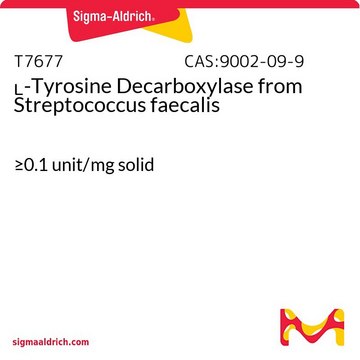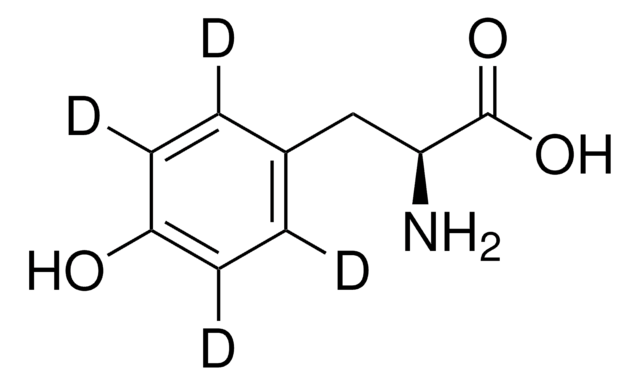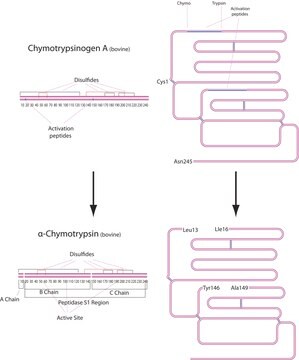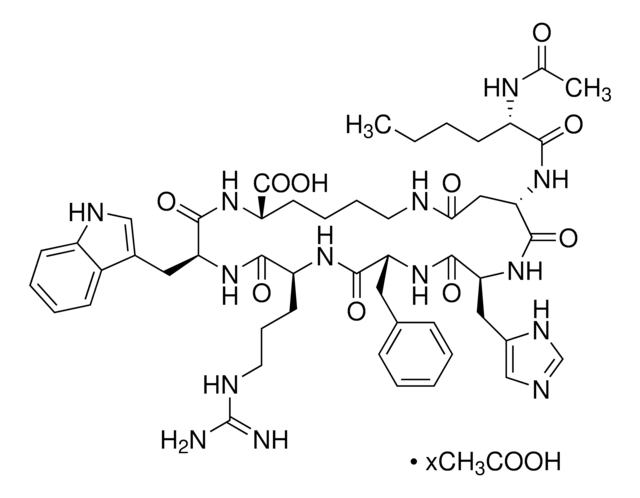추천 제품
애플리케이션
L-Tyrosine decarboxylase apoenzyme from Streptococcus faecalis has been used:
- in a study to purify and characterize tyrosine decarboxylase and aromatic-L-amino-acid decarboxylase
- in a study to investigate the stereospecificity of sodium borohydride reduction of tyrosine decarboxylase
- in protein synthesis studies
생화학적/생리학적 작용
L-Tyrosine Decarboxylase Apoenzyme is an aromatic L-amino acid decarboxylase. The enzyme activity of tyrosine decarboxylase (TDC) is dependent on the cofactor pyridoxal 5-phosphate (PLP). It catalyzes the decarboxylation of dihydroxyphenylalanine.
기타 정보
Dried cells grown on vitamin B6-deficient medium.
단위 정의
One unit will liberate 1.0 μmole of CO2 from L-tyrosine per min at pH 5.5 at 37 °C.
Storage Class Code
11 - Combustible Solids
WGK
WGK 3
Flash Point (°F)
Not applicable
Flash Point (°C)
Not applicable
개인 보호 장비
Eyeshields, Gloves, type N95 (US)
Gunsalus, I.C., and Smith, R.A.
Methods in Enzymology, 3, 963-963 (1957)
Haixia Zhu et al.
Scientific reports, 6, 27779-27779 (2016-06-14)
Tyrosine decarboxylase (TDC) is a pyridoxal 5-phosphate (PLP)-dependent enzyme and is mainly responsible for the synthesis of tyramine, an important biogenic amine. In this study, the crystal structures of the apo and holo forms of Lactobacillus brevis TDC (LbTDC) were
E E Smissman et al.
Journal of medicinal chemistry, 19(1), 161-163 (1976-01-01)
2,2-Dimethyl-4-imidazolidinone derivatives of the alpha-amino acids DL-phenylglycine (1), DL-phenylalanine (2), L-tyrosine (3), L-histidine (4), and L-tryptophan (5) were prepared in order to assess their specificity in inhibiting amino acid decarboxylases. Treatment of th alpha-aminonitriles with acetone in the presence of
J C Vederas et al.
The Journal of biological chemistry, 254(12), 5053-5057 (1979-06-25)
Sodium boro[3H]hydride reduction of tyrosine decarboxylase from Streptococcus faecalis followed by complete hydrolysis of the enzyme produces epsilon-[3H]pyridoxyllysine. Degradation of this material to [4'-3H]pyridoxamine and stereochemical analysis with apoaspartate aminotransferase shows that the re side at C-4' of the cofactor
T Miura et al.
International journal of cancer, 46(5), 931-934 (1990-11-15)
Phenolic melanin precursors can be utilized for the development of anti-melanoma agents. The sulphur homologue of tyrosine, 4-S-cysteinylphenol (CP) and its decarboxylation product, 4-S-cysteaminylphenol (CAP) were shown to be substrates of melanoma tyrosinase, forming melanin-like pigment. Both, but in particular
자사의 과학자팀은 생명 과학, 재료 과학, 화학 합성, 크로마토그래피, 분석 및 기타 많은 영역을 포함한 모든 과학 분야에 경험이 있습니다..
고객지원팀으로 연락바랍니다.








